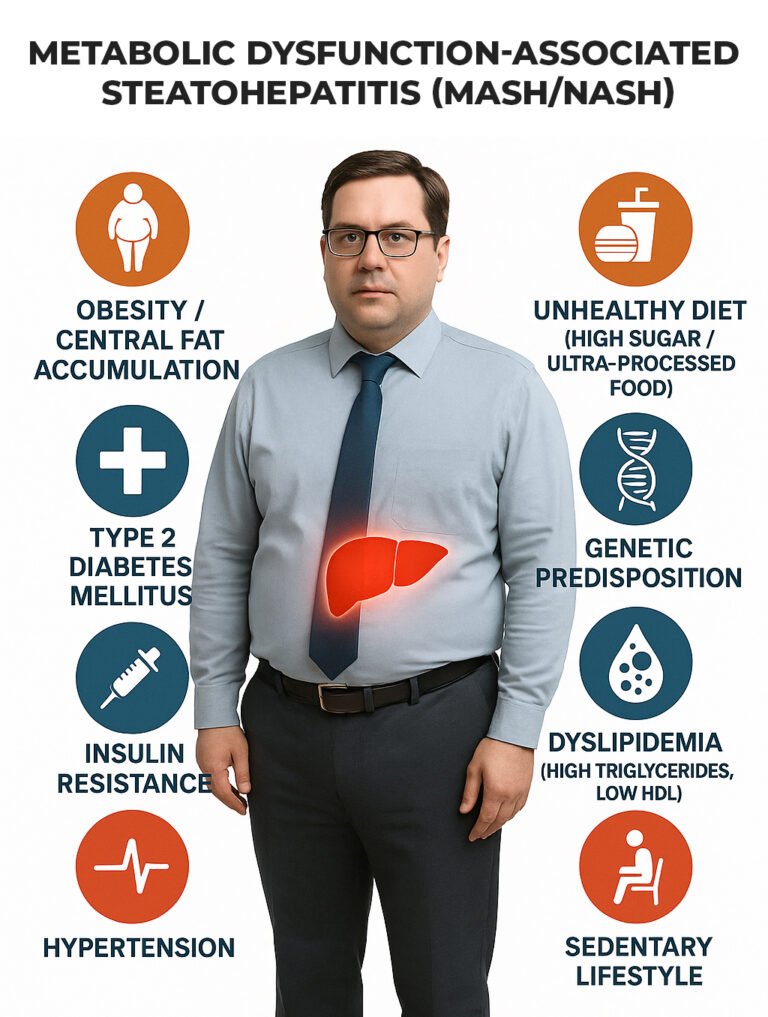Non Alcoholic Fatty Liver Disease
Non Alcoholic Fatty Liver Disease (Metabolic dysfunction associated steatohepatitis) NASH/MASH
Non-Alcoholic Steatohepatitis (NASH) or Metabolic dysfunction Associated Steatohepatitis (MASH) share several risk factors that contribute to their development. These conditions are characterized by fat accumulation in the liver, inflammation, and varying degrees of fibrosis, potentially progressing to cirrhosis or liver failure.

Major Risk Factors for NASH/MASH
Obesity
- Excess body fat, particularly visceral fat, is strongly associated with fat accumulation in the liver.
- Central obesity (waist circumference) is a key marker of risk.
Type 2 Diabetes Mellitus (T2DM)
- Insulin resistance is a primary driver of NASH/MASH.
- Patients with T2DM are more likely to develop severe liver disease due to metabolic dysfunction.
Metabolic Syndrome
- This cluster of conditions includes:
- Central obesity.
- Elevated blood pressure.
- Dyslipidemia (high triglycerides, low HDL cholesterol).
- Hyperglycemia or insulin resistance.
- Metabolic syndrome significantly increases the risk of liver inflammation and fibrosis.
Dyslipidemia
- High levels of triglycerides and low HDL cholesterol contribute to liver fat deposition and inflammation.
Genetic Predisposition
- Genetic variants such as PNPLA3, TM6SF2, and MBOAT7 are linked to increased susceptibility to NASH/MASH.
- Family history of liver disease or metabolic conditions also increases risk
Age and Gender
- Risk increases with age, particularly in individuals over 50 years.
- Postmenopausal women may have a higher risk due to hormonal changes.
Sedentary Lifestyle
- Physical inactivity contributes to weight gain, insulin resistance, and dyslipidemia, all of which promote NASH/MASH.
Dietary Factors
- High consumption of:
- Sugary beverages and processed carbohydrates.
- Saturated fats and trans fats.
- Fructose, particularly from sweetened foods.
- Low intake of fiber, omega-3 fatty acids, and antioxidant-rich foods.
Gut Dysbiosis
- Imbalance in the gut microbiota can lead to increased intestinal permeability and release of inflammatory cytokines, promoting liver inflammation.
Medications
- Certain drugs, such as corticosteroids, tamoxifen, and amiodarone, can induce or exacerbate liver steatosis.
Polycystic Ovary Syndrome (PCOS)
- PCOS is associated with insulin resistance and obesity, increasing the risk of NASH/MASH in women.
Hypothyroidism
- Underactive thyroid function can contribute to metabolic dysfunction and liver fat accumulation.
Sleep Disorders
- Conditions like obstructive sleep apnea are linked to systemic inflammation and insulin resistance, aggravating NASH/MASH risk.
Chronic Stress
- Prolonged stress can alter hormonal balance and promote weight gain, contributing to metabolic dysfunction and liver disease.
Summary
NASH/MASH risk factors are primarily metabolic in nature, with obesity and insulin resistance being central drivers. Genetic predisposition and lifestyle factors further modulate the risk. Early identification and management of these risk factors through lifestyle modifications, dietary changes, and medical interventions are crucial to prevent progression to severe liver disease.
